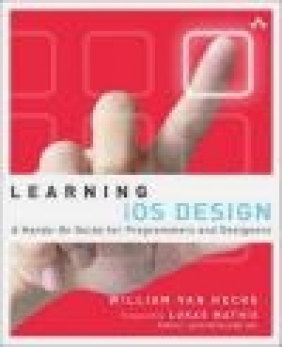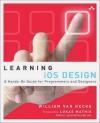Learning iOS Design
William Van Hecke
Learning iOS Design
William Van Hecke
- Producent: Addison Wesley Publishing Company
- Rok produkcji: 2013
- ISBN: 9780321887498
- Ilość stron: 352
- Oprawa: Miękka
Niedostępna
Opis: Learning iOS Design - William Van Hecke
"This book contains everything you need to know to create awesome, life-altering applications...I pride myself on knowing a lot about design, but when reading this book, I probably didn't encounter a single page that didn't offer at least one interesting idea, new concept, or clever design technique. It's also written in a way that prevents you from putting it down...You're in for a treat." -From the Foreword by LUKAS MATHIS, author of ignorethecode.net Transform Your Ideas into Intuitive, Delightful iOS Apps! As an app developer, you know design is important. But where do you start? Learning iOS Design will help you think systematically about the art and science of design, and consistently design apps that users will appreciate-and love. Pioneering Omni Group user experience expert William Van Hecke first explains what design really means, and why effective app design matters so much. Next, using a sample concept, he walks through transforming a vague idea into a fleshed-out design, moving from outlines to sketches, wireframes to mockups, prototypes to finished apps. Building on universal design principles, he offers practical advice for thinking carefully, critically, and cleverly about your own projects, and provides exercises to guide you step-by-step through planning your own app's design. An accompanying website (learningiosdesign.com) provides professional-grade sketches, wireframes, and mockups you can study and play with to inspire your own new project. Coverage includes * Planning and making sense of your app idea * Exploring potential approaches, styles, and strategies * Creating more forgiving, helpful, and effective interactions * Managing the constraints of the iOS platform (or any platform) * Crafting interfaces that are graceful, gracious, and consistently enjoyable to use * Balancing concerns such as "focus versus versatility" and "friction versus guidance" * Understanding why all designs are compromises-and how to find the best path for your own app Register your book at informit.com/register to gain access to a supplemental chapter in which Bill Van Hecke discusses the design changes made in iOS 7.Foreword xix Preface xxi Acknowledgments xxix About the Author xxxi Part I: Turning Ideas into Software 1 Chapter 1: The Outlines 3 The Process: Nonlinear but Orderly 3 Writing about Software 4 The Mental Sweep 6 More Inputs to Outlining 7 Outlining Requirements 8 Antirequirements 9 Define a Platform 10 Listing Ramifications 11 iOS and Featurefulness 11 Reducing Problems 12 Outlining Architecture 13 Your Outline Is Your To-Do List 14 Summary 14 Exercises 14 Chapter 2: The Sketches 15 Thinking by Drawing 15 Design Happens in Conversations 16 Tools for Sketching 18 Sketches Are Sketchy 19 When to Sketch 20 Using Precedents 21 Playing Devil's Advocate 22 Sketching Interfaces 22 Sketching Interactions 24 Sketching Workflows 26 Summary 29 Exercises 29 Chapter 3: Getting Familiar with iOS 31 Navigation: Screen to Screen 31 Advice on the Standard Elements 41 Custom Controls 52 Summary 53 Exercises 53 Chapter 4: The Wireframes 55 Thinking in Screens 56 Thinking in Points 57 Optical Measurements 57 Tools for Wireframing 61 Principles of Layout 63 Typography 72 Layout: A Place for Everything... 74 Summary 79 Exercises 80 Chapter 5: The Mockups 81 When to Mock Up 81 Styling: The Apparent Design Discipline 82 Mockup Tools 85 Color: Thinking in HSB 86 Get Serious about Value 88 Contrast: Thinking in Figure/Ground Relationships 89 Styling for Good Contrast and Visual Weight 89 Good Backgrounds 92 Transparency 93 1+1 = 3 94 Presenting Image Content 95 Evaluating Contrast: Posterize It 95 Contrast Examples 98 Birth of a Button 100 Mockup Assembly 106 Resizable Images 107 Retina Resources 107 Designing for Layers 108 Summary 109 Exercises 109 Chapter 6: The Prototypes 111 Test on the Device 111 Kinds of Prototypes 112 Paper Prototypes 112 Wizard of Oz Prototypes 114 Motion Sketches 115 Preemptive Demo Videos 117 Interactive Prototypes 118 Proof-of-Concept Software 121 Why Do Usability Testing? 123 How to Do Usability Testing 124 Summary 126 Exercises 126 Chapter 7: Going Cross-Platform 127 Platform Catalog 127 Standalone, Mini, and Companion Apps 129 Start from Scratch 130 Back to the Outlines 130 Case Study: Apple Mail 131 Summary 141 Exercises 142 Part II: Principles 143 Chapter 8: The Graceful Interface 145 Suspension of Disbelief 145 The Moment of Uncertainty 146 Instantaneous Feedback 147 Gracefulness through Layout 149 Six Reliable Gestures 151 The Sandwich Problem 153 Exotic Gestures as Shortcuts 154 Realistic Gestures 154 Hysteresis 155 Thresholds 157 Generous Taps 158 Meaningful Animation 161 Making SnackLog Graceful 163 Summary 164 Exercises 164 Chapter 9: The Gracious Interface 167 Denotation and Connotation 167 Cues 168 Imagery 171 Text 172 Writing: The Secret Design Discipline 174 Redundant Messages 176 Communication Breakdown 176 Guidance at the Point of Need 177 Visible Status 178 Contextual Status 179 Invisible Status 180 The Sense of Adventure 183 Capability 184 Defensive Design 185 Forgiveness 187 Making SnackLog Gracious 191 Summary 193 Exercises 193 Chapter 10: The Whole Experience 195 Serve the Soul 197 Conveying Capability 198 Documentation 206 Support 211 Localization 211 Accessibility 213 Ethos 215 Respect 215 Summary 219 Exercises 219 Part III: Finding Equilibrium 221 Chapter 11: Focused and Versatile 223 Debunking "Simple" and "Complex" 223 The Focused Design 224 Focusing SnackLog: Labeling 228 The Versatile Design 230 Summary 236 Exercises 236 Chapter 12: Quiet and Forthcoming 237 Adjacent in Space 238 Stacked in Time 239 Progressive Disclosure 240 Group by Meaning, Arrange by Importance 242 Promotion and Demotion 243 Splitting the Difference 246 iOS Loves Context 246 Hide, Don't Disable 248 Disappear 248 Taps Are Cheap 250 Loud and Clear 250 Making SnackLog Quiet 251 Making SnackLog Forthcoming 252 Summary 253 Exercises 253 Chapter 13: Friction and Guidance 255 The Difficulty Curve 255 Experience Weight 257 Why Add Friction? 257 How to Add Friction 258 Unintended Friction 259 Guidance 262 Sensible Defaults 266 Summary 270 Exercises 270 Chapter 14: Consistency and Specialization 271 How It All Works Out 271 Getting the Most Out of the HIG 272 The Consistent Design 273 The Specialized Design 278 Summary 283 Exercises 284 Chapter 15: Rich and Plain 285 Color versus Monochrome 286 Depth versus Flatness 290 Realism versus Digitality 296 Summary 301 Exercises 302 Index 303
Szczegóły: Learning iOS Design - William Van Hecke
Tytuł: Learning iOS Design
Autor: William Van Hecke
Producent: Addison Wesley Publishing Company
ISBN: 9780321887498
Rok produkcji: 2013
Ilość stron: 352
Oprawa: Miękka
Waga: 0.54 kg






















